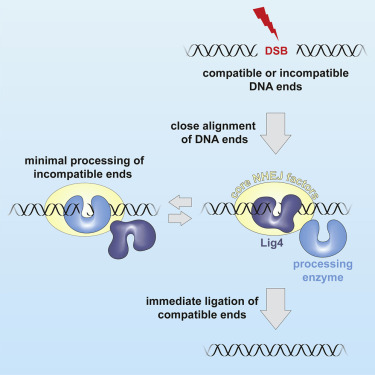Our official English website, www.x-mol.net, welcomes your feedback! (Note: you will need to create a separate account there.)
A Mechanism to Minimize Errors during Non-homologous End Joining.
Molecular Cell ( IF 16.0 ) Pub Date : 2019-12-17 , DOI: 10.1016/j.molcel.2019.11.018 Benjamin M Stinson 1 , Andrew T Moreno 1 , Johannes C Walter 2 , Joseph J Loparo 1
Molecular Cell ( IF 16.0 ) Pub Date : 2019-12-17 , DOI: 10.1016/j.molcel.2019.11.018 Benjamin M Stinson 1 , Andrew T Moreno 1 , Johannes C Walter 2 , Joseph J Loparo 1
Affiliation

|
Enzymatic processing of DNA underlies all DNA repair, yet inappropriate DNA processing must be avoided. In vertebrates, double-strand breaks are repaired predominantly by non-homologous end joining (NHEJ), which directly ligates DNA ends. NHEJ has the potential to be highly mutagenic because it uses DNA polymerases, nucleases, and other enzymes that modify incompatible DNA ends to allow their ligation. Using frog egg extracts that recapitulate NHEJ, we show that end processing requires the formation of a "short-range synaptic complex" in which DNA ends are closely aligned in a ligation-competent state. Furthermore, single-molecule imaging directly demonstrates that processing occurs within the short-range complex. This confinement of end processing to a ligation-competent complex ensures that DNA ends undergo ligation as soon as they become compatible, thereby minimizing mutagenesis. Our results illustrate how the coordination of enzymatic catalysis with higher-order structural organization of substrate maximizes the fidelity of DNA repair.
中文翻译:

一种在非同源末端连接期间最小化错误的机制。
DNA的酶促处理是所有DNA修复的基础,但必须避免不适当的DNA处理。在脊椎动物中,双链断裂主要通过直接连接DNA末端的非同源末端连接(NHEJ)进行修复。NHEJ具有高度致突变性的潜力,因为它使用DNA聚合酶,核酸酶和其他修饰不相容DNA末端的酶来连接。使用能概括NHEJ的蛙卵提取物,我们表明最终加工需要形成“短程突触复合物”,其中DNA末端在连接能力状态下紧密对齐。此外,单分子成像直接表明加工发生在短程复合物中。将末端加工限制为可连接的复合物,可确保DNA末端一旦相容就立即进行连接,从而最大程度地减少了诱变。我们的结果说明了酶催化与底物高阶结构组织的协调如何使DNA修复的保真度最大化。
更新日期:2019-12-18
中文翻译:

一种在非同源末端连接期间最小化错误的机制。
DNA的酶促处理是所有DNA修复的基础,但必须避免不适当的DNA处理。在脊椎动物中,双链断裂主要通过直接连接DNA末端的非同源末端连接(NHEJ)进行修复。NHEJ具有高度致突变性的潜力,因为它使用DNA聚合酶,核酸酶和其他修饰不相容DNA末端的酶来连接。使用能概括NHEJ的蛙卵提取物,我们表明最终加工需要形成“短程突触复合物”,其中DNA末端在连接能力状态下紧密对齐。此外,单分子成像直接表明加工发生在短程复合物中。将末端加工限制为可连接的复合物,可确保DNA末端一旦相容就立即进行连接,从而最大程度地减少了诱变。我们的结果说明了酶催化与底物高阶结构组织的协调如何使DNA修复的保真度最大化。



























 京公网安备 11010802027423号
京公网安备 11010802027423号